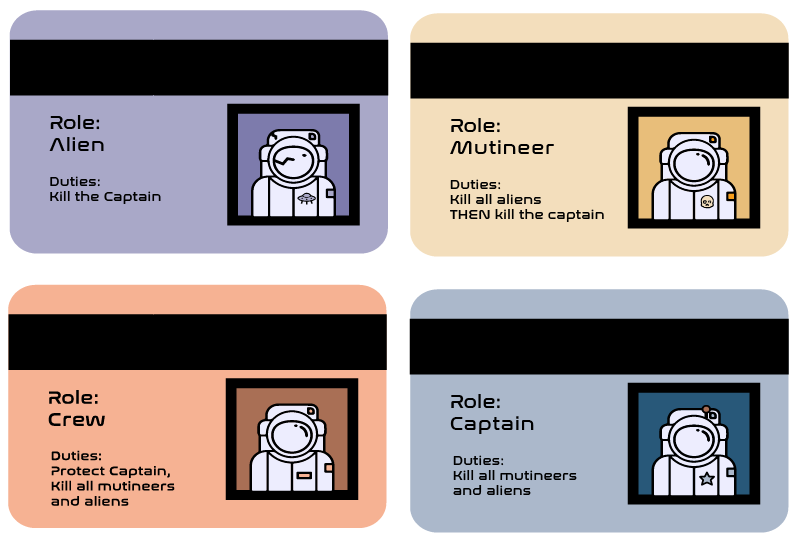We Are Not Alone…
Timeline: Sep 2018 – Dec 2018
Project Type: Personal Project
Role: Game Designer and Illustrator
Tools: Adobe Illustrator
Skills: Storyboarding, wireframing, prototyping, and illustration
This game was a project between a friend and I. We grew up playing board games together. Inspired by the strategic nature of games like Mafia or Bang the Bullet!, we set off to create our own game that would incite a bit of friendly deception.
A Game of Deception
You and your crewmates are trapped in a spacecraft with aliens onboard. You don’t know who is who and time is running out to save Earth. The captain and his loyal crew want to send the ship hurtling towards the sun to wipe out all traces of alien life. But the mutineers, all wanting to see their families again, want to take the risk of killing the aliens before taking over the ship and flying back home. The aliens, hidden amongst the astronauts, just need to bide their time before taking over the ship. Who shall win this cosmic clash?
We Are Not Alone is a deception-based card game, in which players are secretly assigned roles and attempt to survive by completing their respective mission based on their roles. During a turn, each player loads their laser gun by playing a cartridge card face down. After a countdown from 3, each player points at their target. The current player then select the order at which everyone reveals their cartridge and shoot. Depending on what cartridges are played, players can assist suspected teammates’ survival or vaporize their suspected enemies.
Sketches
During the initial ideations of the game, we used playing cards to test out ideas. We liked the idea of role cards, in which players had their own identity and goals. Having a secret to keep from other players was the driving point for a deception-based game. Unlike Mafia, where your role was generally binary (civilian or mafia), we wanted each role to be unique to the player. Additionally, each role had to have some goals that required helping other roles as well as their own just to encourage temporary alliances across the game.

Initial Role Designs
Captain: Kill the mutineers and the aliens
Crew: Ensure the Captain survives. Kill the mutineers and the aliens
Mutineer: Kill all the aliens then kill the Captain
Aliens: Kill the Captain or survive for (number of players + 2) turns
Prototyping
My teammate and I held weekly design meetings, where we would come back with insights from our testing as well as sketches for the creative direction. The initial theme was not space, but actually a cowboy western theme; however, this overlapped too similarly with Bang the Bullet! card game. We actually considered a nautical theme with crewmates and pirates before settling on the the space theme.
Beginning sketches of themes and design inspirations
Illustrations of cartridge, health, and role cards
Beginning with rough sketches of the cards, we visualized the card types that we would use when playing the game. Sometimes if we liked an idea enough, we would print them out and try playing them with cut-outs of the card as a prototype. As the cards gained their identity, we started creating higher fidelity illustrations.

Low fidelity sketch

Mid fidelity mockup v1

Mid fidelity sketch v2
Printing physical copies
After settling on a design where we were happy with the intent and flavor of each card, we wanted to print the physical card game. I began by looking up sites that printed custom playing cards for prototyping card games and settled on one based on their pricing, reviews, and card options.
I had the responsibility of deciding the card material and processing our designs into the layout that matched the specs of the manufacturer.
Arranging card layouts
The options of card material was black core(310 gsm), linen(210 gsm) and glossy (295 gsm). I had ordered a sample to compare the three materials. The black core had a glossy finish and had a premium cost because it carried a core that could not be seen through and is typically the standard for casino playing cards. The linen was a lighter material with a textured matte feel that felt nice and sturdy. However, the linen was also the most prone to damage and wear over time. The glossy material was thick, shiny, and was the most affordable option.
We ultimately went with the linen finish for our first prototype because we enjoyed the feel and sturdiness of the finish. The matte finish gave the cards a more appealing look than the glossy finishes. Additionally, the price was in between the black core and glossy options, which was reasonable for a single print of our card game.
The Maiden Voyage
This was the second game design project I participated in and the first one where I have created a physical product out of it. Although the gameplay of this game was simple since it could be played just a deck of regular playing cards, I think the bigger challenge of the development of this game was developing the flavor of the game. The visual design and atmosphere should mesh and complement the game mechanics to make sense of the game world, adding immersion to the play. I have learned that having a vision of the story of the game can drive impactful design decisions just as interactive game mechanics can drive them. By considering both perspectives, I felt that our team designed a fun game.














